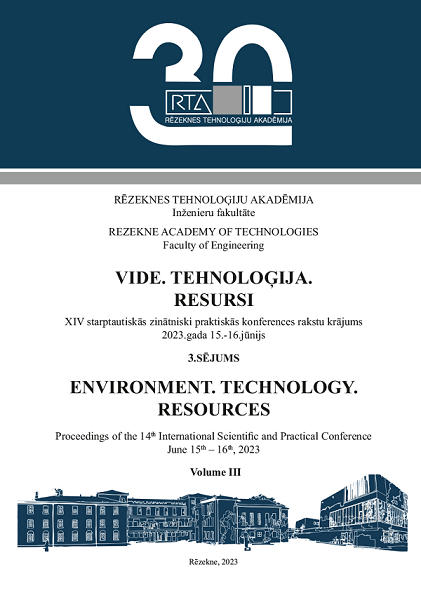FEATURES OF COLOR LASER MARKING ON METALS
DOI:
https://doi.org/10.17770/etr2023vol3.7222Keywords:
color marking, laser, marking, power, speedAbstract
In the research carried out at the Rezekne Academy of Technology, the technology for color laser marking on chromium-nickel base and other metal bases was used in industrial production from the point of view of the repeatability and stability of the produced color markings. The study and research was done during the Erasmus internship by the authors at the Academy of Technology in Rezekne, Latvia. For this purpose, an AISI 304 color palette consisting of fifteen colors was developed and implemented. After the practical experiments, the dependence of the obtained colors on the various parameters of the laser processing was analyzed. The resulting colors were then tested using optical, scanning electron and atomic force microscopy, and the configuration of the oxide films was determined by Raman spectroscopy. The resulting colors are of appropriate uniformity, brightness and cover almost all spectral zones, and the resulting colors are of many times better quality than other metallic bases. A color standardization and palette repeatability test was also performed by evaluating the reflectance spectra of the formed colors. The color palette demonstrated high repeatability for all but one particular color. In parallel, the stability of the color markings was studied in terms of environmental, mechanical and chemical resistance. The resulting colors show high resistance to most environmental conditions; however, exposure to very high temperatures and extreme humidity (100 °C, 90%) and to low temperatures and extreme humidity (-40 °C, 90%) results in degradation of several colors. Colored brands show high hardness and excellent mechanical resistance to external influences and exceptional resistance to various chemicals, except for acid solutions and salts.
References
Dave Ahearn, ONR Laser Power Jumps 10 Fold; Further 10 - Fold Leaps Seen, Defense Today, August 4, 2004, p. 4
N. Todorov, Lyubomir L., Shterev I.J., Dimitrov N.D. and Ivanov L.L. 2019 Study of cutting and labeling of polymethylmethacrylate using a CO2 laser Vide. Tehnologija. Resursi -Environment, Technology, Resources. ISBN 1691-5402, Vol 3, 20-22.06.2019 Rezekne, Latvia pp. 37-40.
S. E Lamberson, The airborne laser, Proc. SPIE, Gas Chem. Lasers, vol. 2702, pp. 2702-1_2 702 - 6, Mar. 1996
W. Zhang, Xiao Z. and Yan Z. 1976 Design of online laser marking system by vision guided based on template matching Journal of Physics: Conference Series 1976 012047
L. Lazov, H. Deneva, E. Teirumnieka, Influence of Defocus Position on Laser Cutting Process in Sheet Steel, Environment. Technology. Resources, Rezekne, Latvia Proceedings of the 11 th International Scientific and Practical Conference. Volume III, 163-167,
L. Lazov, Dolchinkov N., Shterev J., Peneva M. and Bozhanova D. 2019 Study of laser cutting and marking on the filt with the help of a CO2-laser Vide. Tehnologija. Resursi - Environment, Technology, Resources, ISBN 1691-5402, Vol 3 pp. 143-147.
L. Lazov, Angelov N., Teirumnieks E. and Teirumnieka E. 2019 Preliminary numerical analysis for the role of speed onto laser technological processes Vide. Tehnologija. Resursi - Environment, Technology, Resources 3 pp 137-142.
N. Petrov, Optimization of the marking process with laser radiation of samples of tool steel, dissertation, Gabrovo, 2011.
N. Dolchinkov, Lazov L., Shterev Y., Lilianova St. and Pacejs A. 2019 Use of CO2 laser for marking and clearing of textile materials for manufacture of military equipment 12th International Scienfic and Practical conference Environment. Technology. Resources. 3, ISBN 1691-540206.2019, Rezekne, Latvia, 32-36
N. Todorov, 2020 Practical research of marking and cutting of textiles with increased resistance, using CO2 laser Journal of Physics: Conference Series 1681 012014, doi:10.1088/1742-6596/1681/1/012014, Online ISSN: 1742-6596, Print ISSN: 1742-6588
S.-T. Tse and Kan C.-W. 2020 Effect of laser treatment on pigment printing on denim fabric: low stress mechanical properties Cellulose 27 10385-10405
N. T. Dolchinkov 2022 Marking and Cutting of Non-metallic Products with CO2 Laser, J. Phys.: Conf. Ser. 2224 012028 DOI 10.1088/1742-6596/2224/1/012028H, doi: 10.1109/Lighting49406.2021.9599072, Electronic ISBN:978-1-6654-3792-9, CD:978-1-6654-3791-2
L. Lazov, Angelov, N., Teirumnieks, E., ...Pacejs, A., Teirumnieka, Ē., Laser ablation of paint coatings in industry, Vide. Tehnologija. Resursi - Environment, Technology, Resources, 2021, 3, pp. 187–194
E. Teirumnieka, Blumberga, D., Teirumnieks, E., Stramkale, V., Product-oriented production of industrial hemp according to climatic conditions, Agronomy Researchthis link is disabled, 2021, 19(4), pp. 2026–2036
L. Lazov, Teirumnieks, E., Angelov, N., Yankov, E., Modification of the roughness of 304 stainless steel by laser surface texturing (LST), Laser Physicsthis link is disabled, 2023, 33(4), 046001
V. Hristov, Lazov, L., Yankov, E., ...Minev, R., Angelov, N., Investigation of the laser effect of micromechanical properties of stainless steel AISI 304 during the marking process, 2021 6th Junior Conference on Lighting, Lighting 2021 - Proceedings, 2021
N. Padarev, Investigation of Damage from Radiological Dispersal Device, International Journal of Innovative Technology and Interdisciplinary Sciences, 5(4), 2022, pp. 1052–1059. https://doi.org/10.15157/IJITIS.2022.5.4.1052-1059.
N. Padarev, Guidelines for improving laser targeting device in military. Technology transfer: fundamental principles and innovative technical solutions, 2022, 38-40. doi: https://doi.org/10.21303/2585-6847.2022.002681
L. Lazov, N. Padarev, Laser Safety in Army Education, Revista, Vol. XXVIII, Nr. 1 (109), ED. Academiei Forţelor Terestre „Nicolae Bălcescu” Sibiu, Romania 2023, ISSN 2247-840X, ISSN-L = 1582-6384, pp. 61–68, DOI: 10.2478/raft-2023-0009
N. Padarev, Analysis of the Relation Between Climate Changes and Security Area, International Conference Knowledge-Based Organization, Vol. XXIV. Conference proceedings 3, Applied technical Sciences and Military Technologies, Sibiu, Rom., 2018, pp 169-173, ISSN 1843-682X, ISBN 978-973-153-329-2.
L. Lazarov, Perspectives and trends for the development of electronic warfare systems, International Conference on Creative Business for Smart and Sustainable Growth, CreBUS 2019, 2019, 8840074
S. Stoykov, Dimitrova, S., Marinov, R., The development of educational capacity of human resources in the field of security-main priority of national security, International Conference on Creative Business for Smart and Sustainable Growth, CreBUS 2019, 2019, 8840062



